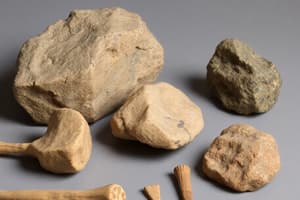Podcast
Questions and Answers
What was the primary purpose of the Great Ziggurat of Ur?
What was the primary purpose of the Great Ziggurat of Ur?
- A residence for the king
- A temple for worship (correct)
- To store agricultural goods
- A military fortress
Which agricultural products were primarily cultivated by the Sumerians?
Which agricultural products were primarily cultivated by the Sumerians?
- Soybeans and oats
- Potatoes and carrots
- Rice and corn
- Wheat and barley (correct)
What was the primary function of the levees in Sumerian irrigation?
What was the primary function of the levees in Sumerian irrigation?
- To store excess rainfall
- To support building structures
- To create boundaries between farms
- To control flooding and direct water to fields (correct)
What system did Sumerians develop related to arithmetic?
What system did Sumerians develop related to arithmetic?
What materials were the earliest sailboats made from?
What materials were the earliest sailboats made from?
For what initial purpose were the first wheels invented?
For what initial purpose were the first wheels invented?
What did Sumerians believe was the cause of diseases?
What did Sumerians believe was the cause of diseases?
Which civilization emerged near the Tigris and Euphrates rivers after the Sumerians?
Which civilization emerged near the Tigris and Euphrates rivers after the Sumerians?
What is the primary distinction between science and technology?
What is the primary distinction between science and technology?
Which of the following best describes the Sumerian civilization?
Which of the following best describes the Sumerian civilization?
Where did the Sumerian civilization primarily develop?
Where did the Sumerian civilization primarily develop?
Which development was NOT attributed to the Sumerians?
Which development was NOT attributed to the Sumerians?
What material was primarily used in the construction of buildings in the city of Uruk?
What material was primarily used in the construction of buildings in the city of Uruk?
How did nomads adapt their lifestyle according to the content?
How did nomads adapt their lifestyle according to the content?
Which geographical feature is associated with the Sumerian civilization?
Which geographical feature is associated with the Sumerian civilization?
Which aspect is a consequence of the co-independence of science and technology?
Which aspect is a consequence of the co-independence of science and technology?
Flashcards are hidden until you start studying
Study Notes
Defining Science and Technology
- Science is the systematic study of the natural world through observation, experimentation, and analysis. It seeks to understand and explain phenomena.
- Technology is the application of scientific knowledge to create tools, processes, and systems that solve problems and improve human lives.
- Science and technology are intertwined, with advancements in one often driving progress in the other.
Early Civilization and the Impact of Science and Technology
- Stone Age: Early humans used stone tools for survival (approximately 2.5 million years ago).
- Nomands: Early humans lived in small, mobile groups called "tribes" of hunter-gatherers, following available food sources.
The Sumerian Civilization (4500 BCE - 2004 BCE)
- Mesopotamia: The "land between the rivers," referring to the Tigris and Euphrates Rivers. It was also called the "fertile crescent" due to its rich agricultural resources.
- The Sumerians were the first to establish a civilization in Mesopotamia, developing advancements in agriculture, language, governance, and architecture.
- Cities: The Sumerians built cities along the rivers of southern Mesopotamia, including Eridu, Uruk, Ur, Larsa, Isin, Adab, Kullah, Lagash, Nippur, and Kish.
- City of Uruk (First True City): Built with mud bricks, demonstrating early urban planning.
- Ziggurats: Temples built in the center of cities, serving as both religious centers and residences for the ruling king. The "Great Ziggurat of Ur" (Mountain of God) was dedicated to Nanna, the moon god.
- Agriculture: The Sumerians cultivated wheat, barley, grapes, onions, and raised sheep, goats, and cows.
- Irrigation System (Levees): Complex canal systems were used to bring water to farmland, prevent flooding, and control water flow.
- Cuneiform Writing: The first writing system, based on pictures and triangular symbols pressed into clay tablets using reed styluses. It was used for record keeping, trade, storytelling, and personal communication.
- Sumerian Number System (Sexagesimal): A base-60 system, still used today in time measurement (60 minutes in an hour, 60 seconds in a minute).
- Sailboats: Used for transportation, hauling goods, and trade.
- Wheel: First used for agricultural purposes such as grinding grain, later adapting for transportation.
- Plow: Improved efficiency in farming, allowing for larger yields and less labor.
- Medicine: Sumerians believed disease resulted from divine punishment, demonic possession, or evil spirits.
- Exorcists: Used charms and spells to drive away spirits thought to be responsible for illness.
- The Babylonian Civilization (2004 BCE): Emerging alongside the Sumerians, they dominated the region for over 2,000 years.
- Great Builders, Engineers, and Architects: Known for their impressive structures and technical innovations.
Studying That Suits You
Use AI to generate personalized quizzes and flashcards to suit your learning preferences.




